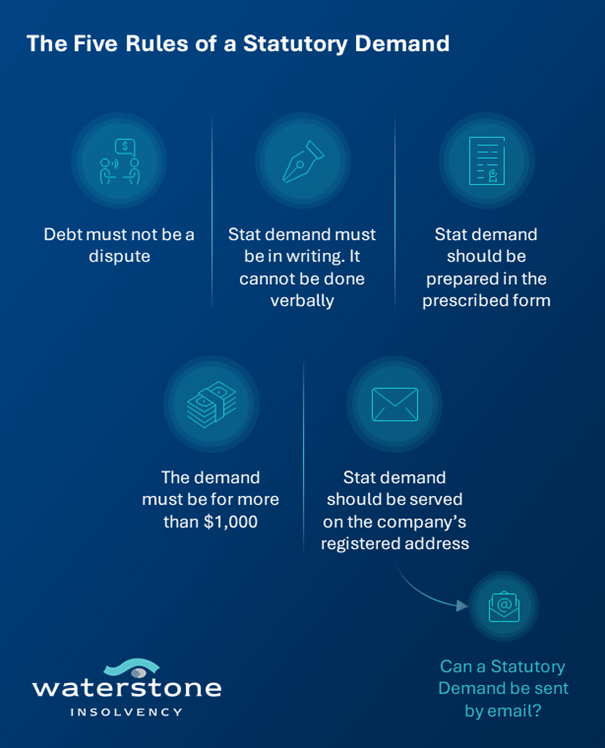A statutory demand is a formal written request served by a creditor to a debtor company, demanding payment of a debt owed. It is the start of the process that can lead to the liquidation to a company.
A statutory demand notice is a legal demand for payment prepared under section 289 of the Companies Act. Once a statutory demand is issued, the debtor company has a period of 10 working days to apply to the court and challenge the demand, or 15 working to comply with the notice and pay the debt. The debtor company also has the option of making other arrangements to settle the debt.
To dispute the issuing of a statutory demand, the debtor must file an application in the court under section 290 of the Companies Act. The advantage of disputing the issuing of a statutory demand by using the Section 290 defense is that the liquidation process is placed on hold. It is risky because if the hearing does not go well, the High Court can place the debtor company into liquidation immediately.
In rare cases, if a 290 hearing is lost by the debtor company, the debtor will be given one or two weeks to settle the debt. If the debtor company fails to find a settlement, the company can be liquidated.
If the debtor company fails to lodge a formal dispute to the court, or the debt is not paid, then the company is presumed to be unable to pay its debts and be considered as an insolvent. In this case, the creditor has 30 working days to file a liquidation application to the High Court.
The liquidation application is usually heard by the High Court within 3 months after the application is lodged. At the court hearing, the creditor is able to use the unpaid statutory demand as evidence that the debtor company is insolvent, and the company should be placed into the liquidation. The High Court will appoint a liquidator chosen by the petitioning creditor.
5 Rules of a Statutory Demand
Before issuing a statutory demand, it is important to consider the following rules.

Defining Undisputed
There are two aspects to a dispute. The first aspect is that the underlying debt is not due. The creditor must show that, if the issue of a statutory demand was put before a defended hearing, there are no realistic prospects that a court would not find that the money was owing. This is a high threshold, although in most cases it isn’t a difficult one to obtain. Most companies seek to obtain an order before delivering a good or service and can provide evidence that the good or service was delivered. If there were no complaints once the work was done, then the burden falls back on the debtor to justify why they should not have to pay.
The second aspect of a dispute is a counterclaim. A common example is when a builder issues a statutory demand for an unpaid invoice, but the customer responds with a counterclaim for the expenses incurred to fix poor workmanship.
Can a Statutory Demand be sent by email?
The Companies Act indicates that the statutory demand should be served on the debtor company. Does this mean that the statutory demand can be sent by email?
This point is the subject of some contention, with different judges giving different rulings. In Upright Scaffolding Ltd v Pinnies Painters & Plasterers Limited, a demand sent via email was deemed effective, as it reached the director and was acknowledged.
Therefore, it is prudent to acknowledge that serving a statutory demand via email might be effective. However, if you are the one serving a statutory demand, opting for a process server to send it would be a wise course of action.
Alternatives to paying the statutory demand
If the debtor company is unable to repay the debt, the company’s shareholders can appoint their own liquidator. Once a winding up notice has been served, which can happen after 15 working days to pay has expired, the debtor company is legally prohibited from appointing a liquidator and must wait for one to be appointed by the court.
Alternatively, the debtor company can enter a Compromise with Creditors (under XIV Compromise of the Companies Act).
The debtor company can also invoke the Voluntary Administration Regime, which will allow an external administrator to be appointed to try and save the company. Voluntary Administration is a complex process and should not be entered in to without a full understanding of what it entails.
If you have received a statutory demand and believe your company is in financial trouble, call us today to explore your options. Waterstone offers a free 30-minute consultation to discuss your financial troubles.
